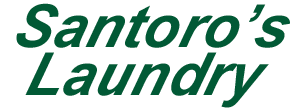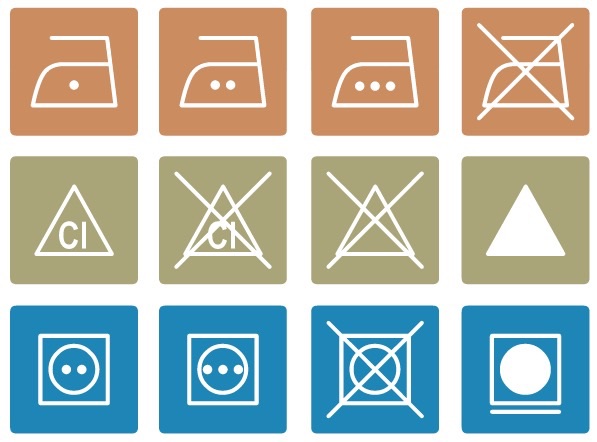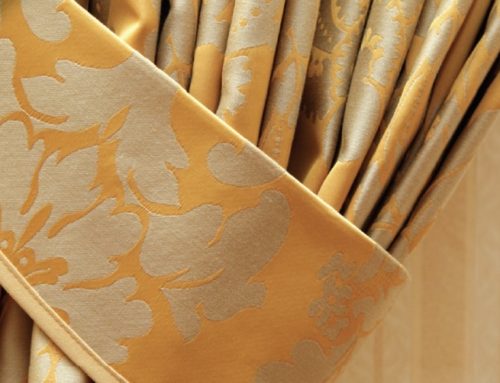The Care Label Rule applies to all clothing except: suede and leather garments, hats, gloves, socks, footwear, reversible garments, and household items such as draperies, linens, and upholstered furniture.
A consumer guide from Santoros Cleaners
The Federal Trade Commission (FTC) requires that garment manufacturers attach a label providing directions for at least one safe method of care. The care label must be easy to find, permanently attached, and remain legible throughout the life of the garment. The manufacturer must have a reason for the recommended care instructions and must warn about any part of the care method that would harm any component of the garment or other garments that may be drycleaned or laundered with it. A care label must also warn when there is no method for cleaning— these typically read: “Do Not Dry Clean,” “Do Not Wash.”
American Care Symbols
The Care Label Rule allows for the use of the American Care Symbol System. The symbols may appear along with or in place of written care instructions. We rely upon our professional affiliation with the Drycleaning & Laundry Institute as a resource for interpreting non-conforming instructions and symbols.
Common Care Label Terms and What They Mean
![]() DRYCLEAN: Any drycleaning process can be used and may include moisture, pressing by steam or steam-air procedures, and drying up to 160ºF.
DRYCLEAN: Any drycleaning process can be used and may include moisture, pressing by steam or steam-air procedures, and drying up to 160ºF.
![]() PROFESSIONALLY DRYCLEAN: The item may be cleaned by varying from a normal drycleaning process. The care label must provide specific instructions.
PROFESSIONALLY DRYCLEAN: The item may be cleaned by varying from a normal drycleaning process. The care label must provide specific instructions. ![]()
SPOT CLEAN ONLY: The only thing that can be done is stain removal without immersing or otherwise cleaning the entire garment.
![]() HAND WASH: This is a gentle soaking process with very limited agitation by hand. Other information may include specific water temperature and drying requirements.
HAND WASH: This is a gentle soaking process with very limited agitation by hand. Other information may include specific water temperature and drying requirements.
![]() MACHINE WASH: This instruction indicates that use of either a commercial or home washer is acceptable. The type of cycle may be specified, such as a gentle cycle. Other information may include specific water temperature, drying requirements, and bleaches that can or cannot be used.
MACHINE WASH: This instruction indicates that use of either a commercial or home washer is acceptable. The type of cycle may be specified, such as a gentle cycle. Other information may include specific water temperature, drying requirements, and bleaches that can or cannot be used.
![]() BLEACH: Care labels on washable garments will usually indicate if bleach can be used and, if so, which type is appropriate. Common terms include: “Do Not Bleach,” “Non-Chlorine Bleach Only,” or “Bleach When Necessary.” If the type of bleach is not specified, any type may be used.
BLEACH: Care labels on washable garments will usually indicate if bleach can be used and, if so, which type is appropriate. Common terms include: “Do Not Bleach,” “Non-Chlorine Bleach Only,” or “Bleach When Necessary.” If the type of bleach is not specified, any type may be used.
![]() TUMBLE DRY: Most garments have tumble or machine drying instructions along with recommended temperatures such as low, medium, durable or permanent press, hot, or no heat. If no temperature is recommended, the garment can be tumbled in a hot dryer.
TUMBLE DRY: Most garments have tumble or machine drying instructions along with recommended temperatures such as low, medium, durable or permanent press, hot, or no heat. If no temperature is recommended, the garment can be tumbled in a hot dryer.
![]() LINE AND DRIP DRY: This instruction means that the garment should be placed on a clothesline or hanger when removed from the washing machine. If a garment is heat sensitive, the label may state, “Line Dry Away from Heat.”
LINE AND DRIP DRY: This instruction means that the garment should be placed on a clothesline or hanger when removed from the washing machine. If a garment is heat sensitive, the label may state, “Line Dry Away from Heat.”
![]() DRY FLAT: Usually found on garments susceptible to stretching when wet (such as sweaters), this instruction entails placing the garment on a towel in order to absorb moisture as it dries or using a drying rack with an open grid that allows air to circulate completely around the garment.
DRY FLAT: Usually found on garments susceptible to stretching when wet (such as sweaters), this instruction entails placing the garment on a towel in order to absorb moisture as it dries or using a drying rack with an open grid that allows air to circulate completely around the garment.
![]() IRON: If ironing is recommended, iron or temperature settings are usually stated. Instructions may include: “Cool/Low Iron,” “Warm/Medium Iron,” “Hot Iron,” “Iron on the Wrong Side Only,” “Steam,” “Do Not Steam,” “ Iron Damp.” If no temperature or setting is stated, the highest setting can be used.
IRON: If ironing is recommended, iron or temperature settings are usually stated. Instructions may include: “Cool/Low Iron,” “Warm/Medium Iron,” “Hot Iron,” “Iron on the Wrong Side Only,” “Steam,” “Do Not Steam,” “ Iron Damp.” If no temperature or setting is stated, the highest setting can be used.
Does Washable Also Mean Drycleanable or Vice Versa?
It may or may not. The manufacturer is only required to list one method of safe care no matter how many methods could also be used safely. And they do not have to warn if other methods would damage the garment.
Using a Care Method Not Specified on the Label
If a different care method is undertaken, there is some risk. We may, at times, suggest an alternative method based upon our knowledge, skill, or the type of soil or stains on the garment; or you may request a different method. Either way, we will carefully consider all options and advise you before beginning any requested process and may ask that you sign a release from responsibility form.
If There Is No Label
All garments sold in the United States must have a care label. An appropriate care label must also be made available when purchasing fabric that will be used for clothing. Removing the care label entails some risk since care information or warnings are no longer available.
What If There Is a Problem After Care Instructions Are Followed Exactly?
If a garment is damaged or ruined at home even though care instructions were followed, you should return the garment to the retailer. If the retailer is not helpful, you may wish to contact the state or local Office of Consumer Protection or locate manufacturer contact information on the Internet. If the garment was damaged at our store, speak with us directly. If we did not follow the care instructions, we have a responsibility for the results. If we did follow the care instructions, we may be able to assist you with a settlement from the retailer.
To make contact and resolution with a retailer go more smoothly, you should:
- Be prepared with a purchase record or an estimate of approximately when the garment was purchased
- Estimate of the number of times the garment has been washed or drycleaned
- State a resolution that would be satisfactory
Article from Dry Cleaning & Laundry Institute International






